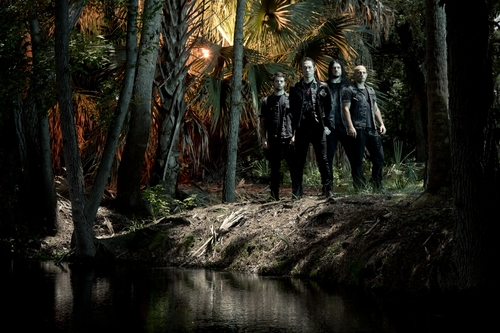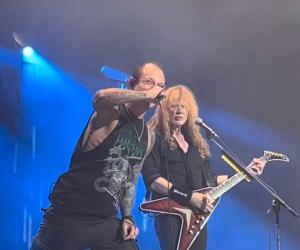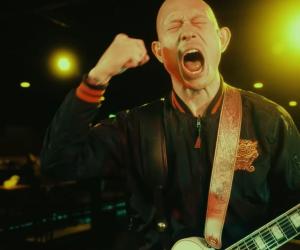
Matt Heafy and Corey Beaulieuof Triviumgave MusicRadar a Metal Masterclass. They dished their advice on getting out the best metal song as well as a few more general things.
1. Set You Blueprint
“Even on Shogun, the choruses have guitar melody, a vocal melody, a rhythm guitar part and other stuff happening on top”
MATT: The song Like Light To The Flies set up several of the blueprints for our band. During the chorus there are semi-interesting guitar chords, then theres a guitar melody on top of that, and the vocals are doing something separate. That was something you see a lot.
COREY: It was the first song we wrote together and its what got the ball rolling and got us signed to Roadrunner. That was one of the first songs we wrote where we tried to incorporate the two ideas of melodies and chords on top of each other.
MATT: Even on Shogun, the choruses have a guitar melody, a vocal melody, a rhythm guitar part and other stuff happening on top.
2. Rhythm = Foundation
“As a kid, I would isolate parts of songs that I felt were exercises I could use”
MATT: I always say that rhythm playing is equal to, if not more important than lead playing, because lead guitar only comes out for bouts… As a kid, I would isolate parts of songs that I felt were exercises I could use.
“For example, down-picking the intro riff for [Metallicas] Blackened is a good one for that. I would sit there and loop it and break it down, and master the song with a metronome.
3. Solo’s Should Serve The Song
"You’ve got to know the riff well enough to play notes that compliment what you’re playing over”
COREY: Listen to what youre playing over what the chords are, the tonality of it and think about what kind of sound is going to fit. Youve got to know the riff well enough to play notes that complement what youre playing over.
“Certain solos, like Forsake Not The Dream from In Waves its a simple chord progression, but if you break it down each section of the solo is played in the chord that youre playing over. It follows the basis of that chord and everything lands on a 3rd or a 5th or a root note.
4. Don’t Be Afraid To F**k Up
"That’s how you learn what works and what doesn’t”
COREY: When learning what notes work for solos, dont be afraid to f**k up, because thats how you learn what works and what doesnt. Its about making it natural, so you can feel it. Train with a buddy playing simple chord patterns. Over time, you develop the ability to play like that without thinking about it, even playing fast.
MATT: I used to just find instrumental music and I would try to solo over it. Its like trying to write a vocal part over a pre-existing thing thats the way I think of solos.
5. Embrace Your Style
“I like to think I’m ‘tasteful shred’”
MATT: For me, I think the style that I do best is melodic not too shred-based. Dad solos! Thats the term I came up with. A dad solo is stuff that you would expect from Peter Frampton, or from the school of Jimmy Page.
COREY: I like to think Im tasteful shred. On the new record, [the song] Through Blood And Dirt And Bone has some really fast stuff thats pretty technical and precise, but then it breaks it up with harmony guitars and melodies. MATT: Thats a good solo project name: Corey Beaulieu presents Tasteful Shred!
6. Create To Inspire
“I love when I can hear a record and picture a movie in my head”
MATT: For me, Shogun is my biggest accomplishment [as a songwriter]. I love when I can hear a record and picture a movie in my head, and I feel with Shogun thats a song that can depict that for a listener.
“The biggest compliment I get from someone being a fan of our band is when theyre inspired to create, whether picking up an instrument, starting a band, painting a picture or telling me what the songs mean to them. I want our creativity to inspire others creativity.
7. Don’t Be Afraid To Simplify
"Guitar players were like, 'Err, why aren’t you guys shredding your asses off?’”
MATT: On Shogun, we had so many ideas and parts per song but on In Waves we really made it about the song and not the technicality. In Waves is a very minimal song. When that song came out, guitar players were like, Err, why arent you guys shredding your asses off?
COREY: Everyone was like, Its too simple! Then they were doing guitar covers and they still werent playing the riff right! It was like, Youre bitching about it being too simple, but how come no-ones playing it right?
MATT: Whats great about In Waves is that someone could sing you a riff to the song and you know what song it is.
8. Know Thy Tone
“All of the bands we listened to growing up, we’d be like, 'What did they use on this album?’ and every one was like, '5150’.”
COREY: When we first started we were usingPeavey5150s. Then we went through all sorts of stuff and eventually, when nothing seemed to be like, Thats the sound, we went back to playing Peaveys.
“Now we know what amps make our sound. In Waves and Shogun were based off a 5150 and Ascendancy had aMesaand a 5150, so for Vengeance Falls we knew, Were going to need an original 5150 block- lettered amp and a Maxon overdrive into a Mesa 4x12.
MATT: With the Vintage 30 speakers. Thats always the starting point.
COREY: All of the bands that we listened to growing up, wed be like, What did they use on this album? And every one was like, 5150. 5150. 5150.
9. Don’t Fear Technology
"If any tube-head elitist compliments our record they can shove it up their ass!”
MATT: Amazingly, this record is recorded with a Kemper Profiling Amp plugged directly into Pro Tools, so theres no mic, no cab and the Vengeance Falls tone is just the Kemper…
“Its a profile of an Andy Sneap tone out of his 5150 amp that Colin Richardson mixed and I consider them the best metal guys for tones.
COREY: So, if any tube-head elitist compliments our record they can shove it up their ass!
MATT: For us, if it works on a record and it works at a 90,000-person festival and people are flipping out then it works!
10. Six Education
Six albums, six lessons learned…
1. Ember To Inferno (2003)
MATT: Err, recording to a click is a good idea!
COREY: I didnt learn anything because I wasnt on it!
2. Ascendancy (2005)
MATT: I learned that when and if your band creates a style for itself
that is iconic and recognisable, perhaps, sometimes, it isnt the best idea to change that!
3. The Crusade (2006)
COREY: With that record, it was standing up for yourself. We got
rushed into the studio, but [after that] we learned to put our foot down and do what we need to do.
MATT: My lesson is that all bands must do vocal in pre-production I didnt know what I was doing until the day we started recording the vocals!
4. Shogun (2008)
MATT: No matter how expensive a studio you record in, it could be the exact same as recording in a laptop studio.
5. In Waves (2011)
COREY: Shogun had some moments recording where I got burned out, whereas In Waves it was like, You can actually make a record and have fun the whole time!
6. Vengeance Falls (2013)
COREY: I learned that we can make a record that sounds amazing in a really short amount of time. You dont need three months to track a record.








